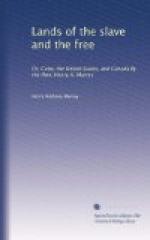Brandon is perhaps the plantation which is more thoroughly kept up than any other on the James River, and which consequently has altered less. I am alluding now to the house and grounds about, not to the plantation at large; for I believe the proprietor at Shirley is reckoned A1 as a farmer. I have before alluded to the blight which destroyed so many fine elms on both shores of the James River. The withering insect appeared at Brandon; but the lady of the house soon proved that she knew the use of tobacco as well as the men, by turning a few hogsheads of the said weed into water, making thereby a murderous decoction, with which, by the intervention of a fire-engine, she utterly annihilated the countless hosts of the all-but invisible enemy, and thus saved some of the finest elms I ever saw in my life, under the shade of which the old family mansion had enjoyed shelter from many a summer’s sun. Brandon is the only place I visited where the destroyer had not left marks of his ravages. The lawn is beautifully laid out, and in the style of one of our country villas of the olden time, giving every assurance of comfort and every feeling of repose. The tropical richness and brightness of leaf and flower added an inexpressible charm to them, as they stood out in bold relief against the pure and cloudless air around, so different from that indistinct outline which is but too common in our moist atmosphere. Then there was the graceful and weeping willow, the trembling aspen, the wild ivy, its white bloom tinged as with maiden’s blush; the broad-leafed catalpa; the magnolia, rich in foliage and in flower; while scattered around were beds of bright and lovely colours. The extremes of this charming view were bounded, either by the venerable mansion over whose roof the patriarchal elms of which we have been speaking threw their cool and welcome shade, or by the broad stream whose bosom was ever and anon enlivened with some trim barque or rapid-gliding steamer, and whose farther shore was wooded to the water’s edge. There is one of the finest China rose-trees here I ever beheld; it covers a space of forty feet square, being led over on trellis-work, and it might extend much beyond that distance: it is one mass of flowers every year. Unfortunately, I was a week too late to see it in its glory; but the withered flowers gave ample evidence how splendid it must have been.
In one of my drives, I went to see an election which took place in the neighbourhood. The road for some distance lay through a forest full of magnificent timber; but, like most forest timber, that which gives it a marketable value destroys its picturesque effect. A few noble stems—however poor their heads—have a fine effect when surrounded by others which have had elbow-room; but a forest of stems, with Lilliputian heads—great though the girth of the stem may be—conveys rather the idea of Brobdingnagian piles driven in by giants, and exhibiting the last flickerings of vitality in a few puny sprouts at their




